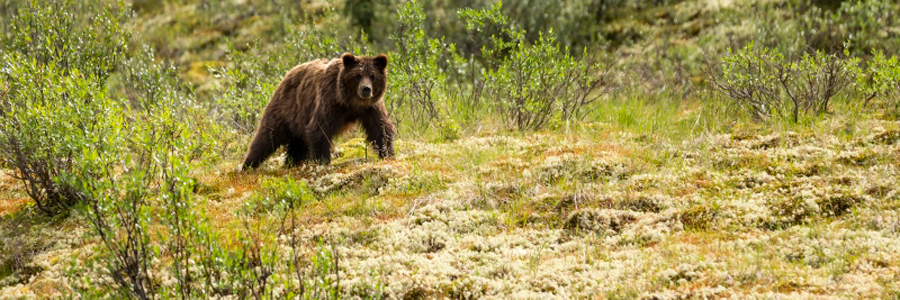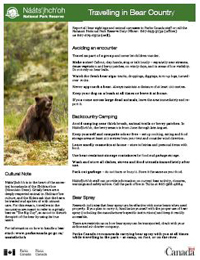
You are in bear country
A Guide to Safety
Nááts’įhch’oh National Park Reserve introduces visitors to a uniquely remote landscape of wild rivers and ancient trails. But this park is more than a scenic wonderland of peaks and rivers. It is home to many animals that depend on the vast wilderness found in Nááts’įhch’oh for their survival.
Why bears do what they do?
- You surprise them.
- They are protecting their young.
- They are guarding a food source such as berries or an animal carcass.
- They follow food and other odours to you.
- Your dog provokes an attack.
- The bear you encounter is habituated to people and has lost its natural fear.
The following guidelines to safety in bear habitat are just that–guidelines. Bear behaviour is hard to predict because they are complex animals. Each bear is an individual with the potential to react differently in different situations. The information that follows will give you some basics on how to avoid an encounter in the first place and guidance on how to react should one occur.
Parks Canada recommends carrying bear spray with you at all times while travelling in the park –at camp, on foot, or on the river.
Bear Spray
Research indicates that bear spray can be effective with some bears when used properly. If you plan to carry it, be aware that wind, spray distance, rain, freezing temperatures and product shelf life can all influence its effectiveness. Familiarize yourself with the proper use of bear spray (including the manufacturer’s specific instructions) and keep it readily accessible. However, the best way to live safely with bears is to avoid contact with them.
When transporting bear spray into the park via float plane or helicopter, inform the charter company in advance that you are bringing bear spray. There are restrictions on how bear spray can be transported. Bear spray cannot be flown on commercial flights (e.g., Edmonton to Yellowknife).
Bears are extremely sensitive to the stress of human activity. You can actually help protect these animals by avoiding encounters with them.

AVOIDING an encounter
Travel as part of a group if possible and never let children wander.
Make noise! Let bears know you're there. Callout, clap hands, sing or talk loudly–especially near streams, dense vegetation and berry patches, on windy days, and in areas of low visibility. (Do not rely on bear bells).
Watch for fresh bear sign. Tracks, droppings, diggings, torn-up logs, turned-over rocks are all signs that a bear has been in the area. Leave the area if the signs are fresh.
Never approach a bear. (Always maintain a distance of at least 100 metres).
Keep your dog on a leash at all times or leave it at home. Dogs can provoke defensive behaviour in bears.
If you come across large dead animals, leave the area immediately and report it to nearby Parks Canada staff or by calling the Nahanni National Park Reserve Duty Officer: 867-695-3732 (landline) or 867-679-6572 (cell).
In Nahanni National Park Reserve, dispose of fish offal in fast moving streams or the deep part of a lake, never along stream sides or lake shores. Fishing is not allowed in Nááts’įhch’oh National Park Reserve, except for local Indigenous traditional use.
Area Closures - for the safety of you and the bears, obey all area closures. Plan alternatives in case of a closure.
Handling an ENCOUNTER
Stay calm and don't alarm the bear with screams or sudden movements. Remain still, stand your ground and assess the situation. Your calm behaviour can reassure it. Bears may bluff their way out of an encounter by charging and then turning away at the last second. Bears may also react defensively by “woofing”, growling, snapping their jaws, and laying their ears back. It’s difficult but important to remain calm if a bear reacts to you this way. A scream or sudden movement may trigger an attack.
Get your bear spray ready. It should be carried with you at all times in an easily accessible location such as your belt or spray deck.
Speak to the bear. Let the bear hear your voice–talk calmly and firmly. Speak slowly and calmly in a non-threatening way. This lets the bear know you are human and not a prey animal. If a bear rears on its hind legs and waves its nose about, it is trying to identify you.
Back away slowly when the bear is stationary, NEVER run! Running may trigger a pursuit and bears can run as fast as a racehorse, both uphill and downhill.
Make yourself less vulnerable – pick up small children and stay in a group.
Don't remove your pack or lifejacket. It can provide protection.
Leave the area or take a detour. If this is impossible, wait until the bear moves away. Always leave an escape route for the bear.
Handling an ATTACK.
DEFENSIVE
What is the bear’s behaviour?
The bear is feeding, protecting its young and/or unaware of your presence. It attacks because it sees you as a threat.
Use bear spray.
If the bear makes contact with you: PLAY DEAD!
PLAY DEAD. Lie on your stomach with legs apart and position your arms so that your hands are crossed behind your neck. This position makes you less vulnerable to being flipped over and protects your face, the back of your head and neck. Remain still until you are sure the bear has left the area.
These defensive attacks are generally less than two minutes in duration. If the attack continues, it may mean the attack has shifted from defensive to predatory–fight back!
Bottom line? It is very difficult to predict the best strategy to use in the event of a bear attack. That is why it is so important to put thought and energy into avoiding an encounter in the first place.
PREDATORY
What is the bear's behaviour?
The bear is stalking (hunting) you along a trail and then attacks. Or, the bear attacks you at night.
DON’T PLAY DEAD. Use bear spray and fight back!
FIGHT BACK! Intimidate that bear: shout loudly; hit it with a branch, paddle or rock, do whatever it takes to let the bear know you are not easy prey. Make yourself looks as large and intimidating as possible. This kind of attack is very rare but it is serious because it usually means the bear is looking for food and preying on you.
Backcountry Camping
To stay safe and respect the land and rivers, travel with two goals in mind: limiting your impact by avoiding encounters and managing your food, food smells and garbage.
Camp in designated areas where provided. Avoid camping near thick brush, animal trails or berry patches. In Nááts’įhch’oh, the berry season is from July-August.
Keep yourself and campsite odour free – set up cooking, eating and food storage areas at least 100 metres from your tent and consider wind direction. Keep sleeping bags, tents and sleeping clothes free of food, food odours or beverages.
Leave smelly cosmetics at home – Store toiletries and personal items with food.
Use bear-resistant storage containers for food and garbage storage. All food should be stored away from camp in secured barrels or canisters.
Store your food, pet food, and garbage away from your tent. There are few trees in many areas of Nááts’įhch’oh, including the lakes where river trips start. If you are in an area with tall trees, hangs should be between two trees at least 4 metres above the ground and 1.3 metres from top and side supports. Food containers should be at least 100m from your tent and secured with ratchet straps or locking rims.
Wash and store all dishes, stoves and food utensils immediately after use. Strain food particles from dish water and store with garbage. Dump strained dishwater in fast-flowing river water. At lake campsites, deposit strained grey water by dispersing widely on land at least 60 metres away from the lake and 100 metres away from your sleeping area.
Pack out garbage – do not burn or bury it. Same storage as food. Deposit solid human waste in catholes (15-20cm) deep at least 60 metres away from camp and trails.
Bear Resistant Food Canisters are recommended for overnight backcountry trips in many parks. Check with park staff before your trip.
Nááts’įhch’oh staff can provide information on current bear activity, closures, warnings and safety advice. Call the park office in Tulita at 867-588-4884.
Report all sightings to park staff
Cultural Note
Nááts’įhch’oh is in the heart of the ancestral homelands of the Shúhtaot’ine (Mountain Dene). Grizzly bears are a deeply respected animal in Shúhtaot’ine culture, and the Elders ask that the bears be treated and spoken of with utmost care. For this reason, travellers in the mountains are meant to refer to a grizzly bear as “The Big Guy”, so as not to disturb the spirit of the bear by using its true name.
- Date modified :
